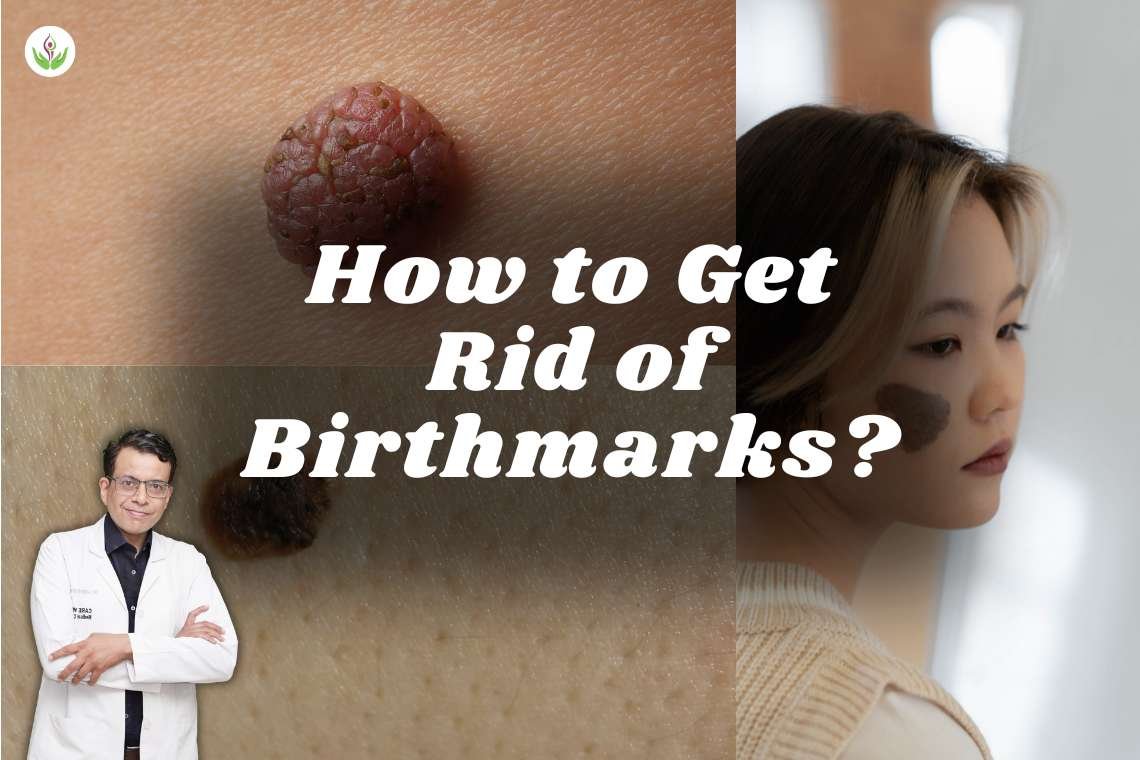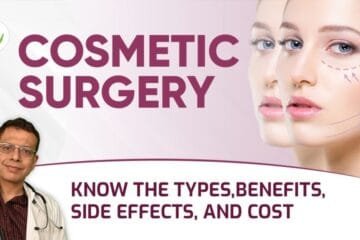People who have birthmarks that bother them can get rid of them or make them less obvious. Some birthmarks go away on their own, but others might need laser therapy, medicine, or surgery to be treated. Want to know how to make birthmarks look less noticeable? Some fade on their own over time, while others may need medical help. Birthmarks can become less noticeable with treatments like laser therapy, surgery, or medicine. But it’s important to see a doctor to figure out what to do next based on the type of scar and where it is located.
What are Birthmarks?
Birthmarks are common marks or spots that appear on the skin either at birth or shortly after. They can show up anywhere on your face, scalp, or body and come in various colors, sizes, shapes, and appearances. Some may blend in with your skin tone but feel different to the touch.
While some birthmarks stick around and may even grow larger over time, others fade away completely on their own. Most birthmarks are harmless, but some could be a sign of an underlying medical issue. Although very rare, some birthmarks might even be cancerous.
In certain cases, people may choose to remove birthmarks for cosmetic reasons.
What Causes a Birthmark?
Contrary to popular belief, cravings or actions during pregnancy do not cause birthmarks. The exact reason why birthmarks form remains unknown. There is no evidence to suggest that anything a pregnant woman does or doesn’t do affects the development of birthmarks on her baby’s skin.
Are Birthmarks Genetic?
Some birthmarks can be hereditary and run in families, but not all of them. While some birthmarks might be the result of gene mutations, most are not.
For instance, certain types of birthmarks, like port-wine stains, can be associated with rare conditions such as Klippel-Trenaunay syndrome or Sturge-Weber syndrome. Even though these conditions are genetically based, family members rarely pass them on.
Can Birthmarks Appear Later in Life?
Birthmarks are typically present at birth or shortly afterward. However, in rare cases, some types of birthmarks may appear during childhood. It’s important to note that marks on the skin that develop later in life, such as moles, are not considered birthmarks.
Types of Birthmarks:
- Pigmented Birthmarks: These occur due to an excess of pigment cells in a specific area of the skin. Examples include moles, café au lait spots, and Mongolian spots.
- Moles (Congenital Nevi): Moles can vary in color and size and may be flat or raised. While some fade over time, others may last a lifetime. Changes in moles should be monitored, as they can sometimes indicate skin cancer.
- Café au Lait Spots: These irregularly shaped spots range in size and are often pale brown in color. They can occur at any time, from birth through early childhood, and may fade over time. Multiple spots may indicate certain medical conditions.
- Mongolian Spots: These flat, bluish-gray spots are common in people with dark skin and are not harmful. They typically occur on the lower back and buttocks and usually fade within a few years.
Understanding Vascular Birthmarks
Extra blood vessels clumping together and becoming visible on the skin are what cause vascular birthmarks. They’re common in about 40% of newborns.
- Salmon Patches: These pink or red patches, also known as angel kisses or stork bites, often appear between the eyes or on the back of the neck. They fade over time and usually don’t need treatment.
- Hemangiomas: These birthmarks can be pink, blue, or bright red and are commonly found on the extremities, head, or neck. They may start small but can grow larger and become elevated during the baby’s first few months. Most fade by adolescence, but some may require medical removal if they grow too quickly or interfere with vital functions.
- Port-Wine Stains: These birthmarks frequently appear on the face and neck because of abnormal blood vessel formation. They start as pink or red patches and may darken over time. Unlike other birthmarks, they don’t fade and may require medical treatment, especially if they occur on eyelids or are associated with genetic conditions.
Why Remove a Birthmark?
Most birthmarks don’t need to be treated, but people with open birthmarks may feel bad about themselves, which can make them less confident. On top of that, doctors may suggest surgery for medical reasons, even though it could leave scars. When thinking about getting a scar removed, it’s important to think about both the psychological and physical aspects. For specific help, talk to a physician.
Who Can Get Birthmark Removal?
Almost anyone can think about getting rid of a birthmark, but the best way to do it will depend on the type of blemish you have. Here are the main types:
- Vascular Birthmarks: These include hemangiomas, port wine stains, and nevus simplex.
- Melanocytic Birthmarks: Examples are congenital melanocytic nevi and café au lait spots.
- Nonmelanocytic Birthmarks: Such as sebaceous and epidermal nevi.
Your doctor will help you choose the right treatment based on the type of birthmark you have.
How Much is the cost of Birthmark Removal in India?
In India, the price of getting rid of a scar can change based on whether your insurance will cover it. Here’s a general idea of the prices:
- Laser Resurfacing: It can cost anywhere from INR 25,000 to INR 30,000 per lesson, and you may need more than one.
- Shave or Surgical Excisions: Most of the time, these treatments cost between INR 60,000 and INR 80,000.
If you were born with arterial birthmarks like hemangiomas, your doctor may give you medicine, and most insurance plans will cover it.
You won’t have to miss work for these treatments, except for the meeting itself.
How do Birthmark Treatments Work?
The treatment for birthmark removal will depend on its type. Here’s how each method works:
- Medication: Certain birthmarks, like some hemangiomas, can be treated with medication. This medication helps shrink the birthmark over time.
- Laser Treatment: Laser therapy is commonly used to treat birthmarks. The laser targets and shrinks the blood vessels in vascular birthmarks, making them less visible.
- Surgical Removal: For some birthmarks, especially ones that are swollen, your doctor may suggest that you have surgery to get rid of them. To do this, you have to cut the scar out of your skin.
Shaving and surgery both get rid of the blemish directly. Lasers, however, work by making blood vessels in arterial birthmarks less visible. Some medicines can help shrink some birthmarks, like hemangiomas.
Procedures for Birthmark Treatments
Laser Therapy:
- Laser therapy helps to lighten red birthmarks, like port wine birthmarks.
- The heat from the laser targets and shrinks or kills blood vessels, which makes the scar less visible.
- It’s most effective when started early, even in infancy, but it can also be used for children and adults.
- Studies have shown that lasers can get rid of some birthmarks totally, like café au lait marks or genetic arterial birthmarks.
Surgery or Shaving:
- Birthmark surgery usually happens in a doctor’s office with local anesthesia. For larger birthmarks, it may be done under general anesthesia in a surgical setting.
- A small scalpel is used to carefully remove the birthmark.
Medication:
- Doctors may prescribe beta-blockers, which are usually for high blood pressure. Because they narrow blood vessels and lower blood flow to the scar, these medicines make it less visible.
- It is also possible to use corticosteroids to reduce the size of blood vessels and birthmarks, especially hemangiomas of childhood.
- These methods work best when the lesion is still growing, which is generally in the first year of life. Most of the time, the scar goes away on its own after that. Surgery or laser treatment can be used to get rid of any parts that are still there.
Targeted Areas for Birthmark Removal
Common Areas:
- Most of the time, birthmarks on the face, head, and neck are taken off because they stand out.
Anywhere on the Body:
- You can get rid of birthmarks anywhere on your body, but if they’re on your back or leg, where they’re less noticeable, you might not need to.
Risks and Side Effects of Birthmark Removal
After Surgery or Shaving:
- Following surgery or shaving to remove a birthmark, it’s important to watch out for signs of infection. These signs may include:
- Pus (a thick, yellowish-white fluid)
- Blood coming from the incision site
- Fluid leaking from the wound
With Medication:
- While it’s rare, certain medications used to reduce birthmarks can have side effects. These may include:
- Slowed heart rate (the heart beating slower than usual)
- Coughing
- Constipation or diarrhea
- Difficulty sleeping
What to Do:
If any of these things happen to your child after getting treatment for a scar, you need to call your doctor right away. They can give you advice and help you figure out the best way to deal with any problems or worries.
Expectations After Each Treatment
Laser Therapy:
- Following laser therapy, you might experience some temporary side effects such as redness, swelling, bruising, or irritation around the treated area. These usually last for about 24 hours.
- To avoid any problems, it’s important to keep the area that was cleaned clean and out of the sun.
- You may notice peeling of the skin around the treated area, which is a normal part of the healing process.
- Generally, the treated area should fully heal within about a week.
- Even though laser therapy can have lasting effects, the scar might not go away fully and might need more treatments.
Surgery:
- After birthmark removal surgery, there’s typically minimal downtime.
- To avoid getting an infection, it’s important to keep the wound clean and dry and to avoid doing anything too hard that could pull out the stitches.
- Surgery generally leaves lasting marks, but there may be some scars where the cut was made.
Medication:
- It could be 14 to 18 months before you see the full effects of the medicine your child is taking.
- These effects are typically permanent.
- For a smooth change, your doctor will probably tell you to slowly stop taking the medicine instead of stopping all at once.
Preparing for Each Treatment
Laser Therapy:
- Your doctor may tell you to stop taking blood-thinning drugs, quit smoking, or drink less alcohol for a few days before your laser therapy visit.
- See if your doctor will tell you who needs to drive you home after the treatment, especially if you will be sedated.
Surgery:
- Before your surgery, ensure that your skin is clean and dry when you arrive for your appointment. This reduces the risk of infection.
- You should talk to your doctor or nurses about any questions you have about the process about one to two weeks before the surgery. This can help ease any worries or stress you might be feeling.
Medication:
- Telling your doctor about any other medicines you are taking is very important. This makes sure that the medicine recommended to get rid of the scar won’t affect any other medicines you are taking.
Home Remedies
It’s important to know that home treatments won’t get rid of or significantly improve the look of birthmarks. Trying home remedies might make things worse. When thinking about how to treat a scar, it’s always best to talk to a doctor first.
Conclusion
In conclusion, most birthmarks don’t need to be removed for medical reasons. There are, yet, ways to hide a scar, such as through surgery, laser treatment, or medicine. However, you should know that these treatments might not work for good, and the costs may change depending on the method used. Also, it’s important to know that if these treatments are done for looks, your insurance company might not pay for them. The best way to figure out the best way to treat birthmarks is to talk to a medical professional.
FAQs About Birthmark Removal
Birthmarks can be treated with laser therapy, surgery, or medication.
Some people feel self-conscious about highly visible birthmarks, and doctors may suggest removal for medical reasons.
Almost anyone can consider it, depending on the type of birthmark.
Costs vary, but laser therapy can range from INR 25,000 to INR 30,000 per session, and surgery typically costs between INR 60,000 and INR 80,000.
Treatments like medication, laser therapy, and surgery work differently depending on the type of birthmark.
After laser therapy, you might experience redness or swelling. Surgery usually has minimal downtime, but there may be some scarring. Medication can take 14 to 18 months for full effects.
Depending on the treatment, you may need to stop certain medications or arrange transportation after laser therapy. Before surgery, ensure clean skin and ask questions. Inform your doctor about any other medications before starting medication treatment.
Home remedies are not effective and could be harmful.
After laser therapy, you may experience redness, swelling, bruising, or peeling for up to 24 hours. It’s essential to keep the area clean and protected from the sun. Healing typically occurs within a week.
Removing birthmarks can result in clearer skin, significantly reduced visibility of the birthmark, increased confidence, and minimal scarring or downtime.
Laser birthmark removal is generally safe and effective, but it entails some risks. Consult a doctor before undergoing laser treatment.
Yes, most birthmarks can be permanently removed with laser treatments, while surgical excision may be necessary for larger birthmarks.
Laser treatment may cause discomfort, often described as small flicks on the skin with a rubber band. Children may require mild sedation or anaesthetic cream to manage pain.
Natural remedies may slightly improve the appearance of certain birthmarks, but complete removal is typically not possible through natural methods.
Most birthmarks are harmless, though some may indicate underlying medical conditions. Consult a doctor if unsure, especially if the birthmark changes unexpectedly.
Most birthmarks do not return after being removed. However, some types may reappear over time, but they can be treated again.
Laser treatment is most effective when started between 6 months and 1 year of age.
Many birthmarks fade or disappear over time without treatment, while others may indicate a more serious medical condition if they develop in large numbers or clusters.
Birthmark removal creams may reduce discoloration but can also increase susceptibility to sun damage or cause uneven skin pigmentation. Results vary.














